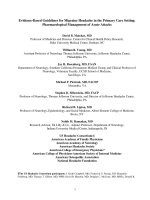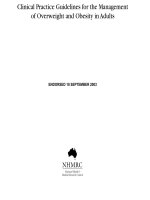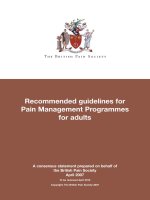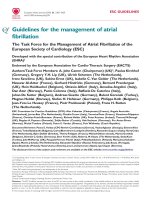Recommended guidelines for Pain Management Programmes for adults pptx
Bạn đang xem bản rút gọn của tài liệu. Xem và tải ngay bản đầy đủ của tài liệu tại đây (130.23 KB, 32 trang )
Recommended guidelines for
Pain Management Programmes
for adults
A consensus statement prepared on behalf of
the British Pain Society
April 2007
To be reviewed April 2010
Copyright: The British Pain Society 2007
ii
Published by:
The British Pain Society
Third Floor
Churchill House
35 Red Lion Square
London WC1R 4SG
Website: www.britishpainsociety.org
ISBN: 978-0-9551546-0-7
iii
Recommended guidelines for
Pain Management Programmes for adults
A consensus statement prepared on behalf of the British Pain Society
Contents
1. Executive summary 1
2. Background 3
3. Pain Management Programmes 5
4. Related pain treatment services 11
5. Patient referral and selection 13
6. Resources 17
7. References 23
iv
1
1 Executive summary
• Pain management programmes (PMPs), based on cognitive
behavioural principles, are the treatment of choice for people with
persistent pain which adversely affects their quality of life.
• There is good evidence for efficacy of cognitive behavioural pain
management programmes as a package, compared with either no
treatment or treatment as usual, in improving pain experience, mood,
coping, negative outlook on pain, and activity levels (Morley et al.,
1999; Guzmán et al., 2001; European Guidelines, 2004; Koes et al.
2006; Hoffman et al., 2007; />conditions/5816.jsp).
• Rehabilitative and physical treatments (back school, functional
restoration, and others) can be helpful, but where problems associated
with pain are more complex, the psychological components of pain
are best addressed in a PMP (Koes et al. 2006).
• PMPs consist of education on pain physiology, pain psychology,
healthy function and self-management of pain problems; and of
guided practice on setting goals and working towards them, identifying
and changing unhelpful beliefs and ways of thinking, relaxation, and
changing habits which contribute to disability. Participants practise
these skills in their home and other environments to become expert in
their application and integration.
• PMPs are delivered in a group format to normalise pain experience, to
maximise possibilities of learning from other group members, and for
economy.
• Evaluation of outcome should be standard practice, assessing
distress/emotional impact of pain, beliefs and thinking biases, range
and level of activity, pain experience, health care use, and work status
where relevant.
• Return to work can be achieved where this is a specific or additional
component of the programme.
2
• Greater length and intensity of programme usually achieve greater
change. Economies of time, staff skills or other resources risk reducing
the effectiveness of the programme towards zero; however, it is not
possible to specify a minimum number of hours since change results
from the interaction of patient needs and staff skills during treatment.
• Suitability for a PMP is based on the impact of pain. There are no
grounds for discrimination on the basis of age, literacy, litigation, or
judgement of motivation.
• A PMP is delivered by a multidisciplinary team where some
competencies are shared and some are unique to particular
professions. All staff use cognitive behavioural principles to deliver their
component/s of the PMP.
• PMPs may be delivered in a primary or a secondary care setting: the
resources required will be the same.
3
2 Background
• Persistent (chronic) pain is a widespread problem which cannot
always be resolved by available medical and physical treatments. Pain
management programmes (PMPs) aim to restore to as normal as
possible the lives of people affected by persistent noncancer pain.
• In 1997, the Pain Society (now British Pain Society) published
Desirable Criteria for Pain Management Programmes in response to
the perceived need for information and guidance for those involved
in the developing field. The document described for the first time
what constituted a Pain Management Programme, though without
any attempt at formal guidelines. It was used by both providers and
purchasers of pain management services. This is the first revision
of that document, extended and updated with reference to current
practice and with particular attention to evidence.
• Since 1997 the status of pain management programmes has grown,
both in evidence base and in the general awareness and acceptance
of this form of care in the spectrum of provision for persistent pain.
However, service development has not kept pace with these changes;
demand continues to outstrip supply (Clinical Standards Advisory
Group, 2000; Dr Foster, 2003). Shortcomings in quantity, combined
with government-led efforts to reduce waiting times, create pressure
to provide pain management services for patients using whatever staff,
facilities and resources are available. This has implications for quality.
• Evidence of effectiveness of PMPs continues to accumulate (Morley
et al., 1999, van Tulder et al., 2000; Guzmán et al., 2001; Hoffman
et al., 2007). However, UK programmes aimed at helping patients
manage their pain are diverse, and their design and procedures may
be influenced as much by pragmatic concerns and available resources
as by published studies and systematic reviews. These latter do not
offer guidance on how to realise the best provision in any particular
situation.
4
• Department of Health philosophy on the management of chronic
illness has changed over this time, with emphasis now on self-
management and community care (for instance, the 2005 National
Service Framework for long term medical conditions (www.dh.gov.
uk/PolicyAndGuidance/HealthAndSocialCareTopics/fs/), and the 2006
Musculoskeletal Services Framework (www.18weeks.nhs.uk).
• These guidelines are written to promote the appropriate provision of
evidence-based treatment and to maintain and improve the quality of
treatment offered to patients. This requires some statement of criteria
for minimum quality which, until data are available, has been achieved
by consensus of involved professionals and by consultation with
relevant bodies. Evaluation of clinical services remains important to
ensure that they are achieving the expected results.
• These recommended guidelines are addressed to health care and
related professionals providing pain management services, to those
who refer patients to these services, and to those who purchase or
commission them and who manage them at present or who have the
opportunity to do so.
Functions of this document:
• To build on the concepts set out in the 1997 document, moving
towards a set of standards of care and guidelines for provision of pain
management.
• To provide pain clinicians of various disciplines with a synthesis of
current best practice.
• To provide commissioners and provider organisations with an outline
framework for effective and sustainable service provision.
• To update stakeholders on the scientific foundation of and quality
issues relating to this treatment.
An accompanying document provides information specifically for patients
about available provision.
5
3 Pain Management Programmes
(PMPs)
PMP content, delivery and outcomes
3.1 A PMP aims to improve the physical, psychological, emotional and
social dimensions of quality of life of people with persistent pain,
using a multidisciplinary team working according to behavioural and
cognitive principles. The problems of people with persistent pain are
formulated in terms of the effects of persistent pain on the individual’s
physical and psychological wellbeing, rather than as disease
or damage in biomedical terms, or as deficits in the individual’s
personality or mental health.
3.2 The principles underlying PMPs can be applied at an early stage to
prevent the development of persistent pain and pain-related disability,
with some evidence for efficacy (Pincus et al., 2001; Linton, 2000;
Linton, 2005). As early identification of those at highest risk for the
development of persistent pain improves, this intervention is likely to
become more cost-effective (Pincus et al., 2001).
Content
3.3 PMP participants apply the programme content to goals important
to them, where pain has had significant negative impact. They aim
to improve their quality of life, working towards their optimal level
of function and self-reliance in managing their persistent pain. Pain
relief is not a primary goal, although improvements in pain have been
reported (Morley et al., 1999; Van Tulder et al., 2000; Guzmán et al.,
2001; Hoffman et al., 2007). Return to work or improved function at
work is an important goal for many, but not for all.
3.4 A PMP consists of education and guided practice.
Education
3.4.1 Education is provided by all members of the multidisciplinary
team, according to their expertise, using an interactive
style to enable patients to raise and resolve difficulties in
understanding material or in applying it to their particular
situations or problems.
6
3.4.2 Some of the information refers to pain mechanisms, to
associated pathologies, and to healthy function and normal
processes:
• Anatomy and physiology of pain and pain pathways;
differences between acute and persistent pain;
• Psychology and pain; fear and avoidance; stress, distress
and depression;
• Safety and risk in relation to increased activity;
• Exercise for better health and improved function;
• Advantages and disadvantages of using aids, treatments
and medication;
• Self-management of flare-ups and setbacks.
3.4.3 Other information introduces treatment principles and
rationales, since these are not intuitively obvious, linking the
information in 3.4.2 to the guided practice described below:
• Mutual influence of beliefs and ways of thinking,
emotions, and behaviour;
• Using cognitive strategies to deal with the psychological
effects of persistent pain and stress;
• Principles of goal-setting;
• Scheduling and regulating goal-directed activity, using
pacing;
• Using cues and reinforcement to help change habits;
generalisation and maintenance of changes;
• Strategies to improve sleep.
7
Guided Practice
3.4.4 Information alone is a weak way to change behaviour. PMPs
are an opportunity for guided practice in use of the methods
outlined above to abolish unhelpful habits and build helpful
habits of activity and of thinking. Guided practice also
enables participants to use help from staff to apply these
changes to their individual goals, starting from their current
level of performance and increasing at a manageable rate.
Participants are instructed to practise in their home and
other environments, monitoring what they do and reviewing
progress with staff regularly, adjusting goals and methods as
necessary.
3.4.5 Exercise to improve fitness and mobility, to improve
confidence in movement and activity, and to enable
increases in goal-related activity. People with persistent
pain who are fearful of activity-related pain or injury are less
likely to transfer exercise gains to improvements in general
function.
3.4.6 Gradual return to goal-defined activities, from self-care to
work, social activities, and sports. This consists both of
analysis of barriers and areas requiring specific change,
and synthesis of the various movements, positions and
tolerances into the integrated activity.
3.4.7 Pacing activity by quota: this is simplest with repetitive
exercise which can be counted or timed and increased
at a steady rate; it is more difficult with complex activities
which require attention to breaks and on which there are
environmental pressures against stopping and starting
strictly to quota (such as driving). Goals involving reduction
of medication and use of aids can be achieved using the
same method.
3.4.8 Identification, elaboration and challenging of appraisals,
beliefs and processing biases related to pain and activity,
using cognitive therapeutic methods.
8
3.4.9 Relaxation skills to enhance breaks, rest and sleep, and as
foundation for attention control methods.
3.4.10 Graded increase in safe but feared activities, increasing
according to resolution of anxiety.
3.4.11 Improvement of communication skills with family, friends
and others, such as work colleagues, or health care
professionals.
Delivery
3.5 The inclusion of additional components will depend on available
resources but should always be properly evaluated. Sacrificing core
components for other content for which evidence is poor or lacking is
to be discouraged.
3.6 The dimensions in which programmes may vary in terms of clinical
input to patients are intensity, length, size of group, individualisation of
clinical input, and competence and training of staff.
Intensity and range
3.7 Historically, these programmes have been delivered as outpatient
programmes, for days or part-days over weeks, or as more intensive,
usually residential, programmes.
3.7.1 Outpatient programmes of at least 25-30 hours have
produced evidence of efficacy, but more intensive
programmes achieve greater improvement (Williams et
al., 1996, 1999; Guzmán et al., 2001). This advantage is
maintained at one-year follow-up.
3.7.2 It is common for programmes to offer post-treatment follow-
up sessions, but these have not been shown to improve
long-term outcome. (Nicholas, 1992)
Group format
3.8 PMPs are delivered to groups because this format normalises the
experience of pain and maximises opportunities to draw on the
experiences of group members. It is also cost effective.
9
3.8.1 Group size varies but most groups aim to have 8 to 12
participants. There is little research to guide group numbers,
and a balance of staff resources (diluted among group
members) and space considerations against demand and
waiting times has to be achieved. Aspects of the group
dynamic are weakened with smaller numbers.
3.8.2 Programme content is tailored to meet the needs of
individual patients, as identified by patients and/or by staff.
However, selecting treatment components based on patient
choice alone is likely to undermine outcome (Morley &
Williams, 2002).
Staff skills
3.9 Staff training is addressed in section 6; there are no data specifically
from PMPs on staff skills in relation to outcome.
Outcomes
3.10 Commissioners, purchasers, referrers and patients expect providers
to deliver an effective PMP. There is no single primary outcome, since
multiple problems imply multiple outcomes, and goals are to a large
extent determined by patients themselves. However, outcomes can
generally be subsumed under the following domains, which were
agreed at a National Consensus meeting in 2000 of staff from UK
PMPs:
• reduced distress/emotional impact;
• normalising of beliefs and information processing (fears,
catastrophic thinking, self-efficacy);
• increase in range and level of activity/physical performance
(observed, self-rated);
• reduced pain experience;
• reduced healthcare use (e.g. medication, consultations);
• improved work status where relevant.
10
3.11 Outcome evaluation should be standard practice so that pain
management staff can describe to patients, referrers and purchasers
the range of patients with whom they work and the range of changes
which the PMP brings about, in both the short and longer term.
Evidence for effectiveness
3.12 There is good evidence for efficacy of both outpatient and inpatient
programmes (www.thecochranelibrary.com; Williams et al., 1996;
Williams et al., 1999; Morley et al., 1999; Van Tulder et al., 2001;
Guzmán et al., 2001). Greater gains are achieved with the more
intensive programmes (Williams et al., 1996, 1999; Guzmán et al.,
2001).
3.13 PMPs have generally been evaluated as a complete package (see
Morley & Williams, 2002). A number of systematic reviews have
shown PMPs to significantly reduce distress and disability and to
significantly enhance coping and improve various measures of physical
performance (Morley et al., 1999; van Tulder et al., 2000; Guzmán
et al., 2001). Where vocational training has been included in the
package, return to work is also significantly enhanced (Hubbard et
al., 1996; Watson et al., 2004). There is also evidence for decreased
use of healthcare resources in terms of numbers of consultations and
reduction of medication (see Morley et al., 1999). Cost effectiveness
data are sparse but positive effects have been demonstrated in other
healthcare systems (e.g. Turk, 2002; Gatchel & Okifuji, 2006).
3.14 Few of the components of a PMP have been evaluated individually.
However,
• The physiotherapy component is drawn from established practice,
supported by randomised controlled trials and by a systematic
review (Hayden et al., 2005).
• Each of the components in 3.4.6 to 3.4.11 is drawn from
behavioural and/or cognitive therapy, with moderate to excellent
evidence of efficacy in changing behaviour, beliefs and mood in
psychological disorders (Roth & Fonagy, 2004), compared with
no treatment or with most alternative treatments. Efficacy in
psychological settings depends in part on the skills of the health
care professional(s) delivering treatment (Roth & Fonagy, 2004).
11
4 Related pain treatment services
4.1 Other rehabilitation programmes, Back School, Functional
Restoration Programme (FRP), and Expert Patient Programme
(EPP) may use the same nomenclature of pain management and/or
some of the same terminology to describe content. However, these
programmes do not use the full set of methods described in section
3, often serve a different population, and have produced less robust
evidence for efficacy (European Guidelines, 2004).
4.1.1
Back School is a form of physical therapy intervention
offered to some patients with acute, recurrent or persistent
low back pain and delivered in groups. Education on proper
back care, usually with an exercise regimen, aims to reduce
pain and related problems and to restore function. The
content of Back Schools has diversified recently (Heymans
et al., 2005)
There is moderate evidence from randomised controlled
trials, in an occupational setting, for people with recurrent
and persistent low back pain, that Back Schools reduce
pain and improve function and work status in the short and
intermediate term (Cohen et al.,1994; Heymans et al., 2005)
compared to exercise alone, manipulation, advice, placebo
or waiting list control.
4.1.2
Functional Restoration Programme (FRP) is a term
commonly used to describe a physical intervention for
patients disabled by persistent pain, and which is delivered
in groups. It takes a physical therapy or sports medicine
approach, with the main aim of restoring physical function
through targeted increases in physical performance. It is
often based within orthopaedic or physiotherapy services;
it may use cognitive and behavioural principles but usually
without the direct involvement of a clinical psychologist or
cognitive behavioural therapist (Frost et al.,1995).
Evidence from a small number of randomised controlled
trials (Frost et al., 1995; Bendix et al., 2000) indicates lasting
benefits in mobility and overall function.
12
4.1.3 An Expert Patients Programme (EPP) is a community-
based self-management programme for people with
long term health conditions, including persistent pain,
and conducted to a protocol by trained leaders, typically
themselves with long term health conditions. The EPP is
usually run over a six week period (NHS Expert Patients
Programme, 2002; Singh, 2005).
The only UK randomised controlled trial showed changes
in confidence and energy, but not in health care use, over 6
months (Kennedy et al. 2007). Uncontrolled studies, mainly
from the USA, largely describe people with rheumatoid
arthritis who show high satisfaction but rather modest
gains in function and reduced health care use (http://
patienteducation.stanford.edu/programs/; Lorig et al., 2000).
4.2
Return to Work programmes (directed at people with persistent
pain) vary widely, from individualised case management which might
incorporate physical and psychological intervention, to a physical and
psychological rehabilitative programme aiming to return people to their
previous work. Single studies show efficacy (Watson et al., 2004).
Condition Management Programmes are planned as an extension of
the Pathways to Work pilot schemes jointly administered by Jobcentre
Plus and the NHS. It is envisaged that Condition Management
Programmes will be delivered primarily by the private and voluntary
sectors with payment by results ( />4.3 UK provision for people with persistent pain incorporates combinations
of the interventions described above, or elements of PMPs as
described in section 3. Many of these interventions have originated
in physiotherapy services, to which at least 90% of people with
persistent pain are referred at least once (CSAG, 2000; Dr Foster,
2003), and use behavioural principles and often cognitive principles
to achieve behaviour change. Evaluation of efficacy for patients with
specified problems, and of cost-effectiveness, will establish whether
these aims have been met: so far, randomised controlled trials show
satisfactory gains compared to ‘treatment as usual’ for those with sub-
acute rather than persistent pain, and for those with mild to moderate
levels of disability (Hay et al., 2005), but these gains are often less
evident at long-term follow-up.
13
5 Patient referral and selection
5.1 Historically, patients have been referred to a PMP only when many
other treatments have failed. This is illogical: it is now recognised that
this treatment should be offered when indicated by persistent pain
causing distress, disability, and a negative impact on quality of life.
5.2 The delays and disappointments inherent in serial treatment by
medical and physical methods, eventually followed by a PMP, are not
in patients’ best interests. Pain management components should be
offered alongside the treatments intended to abolish or reduce the
pain. Initial results on the efficacy of combining pain management
methods with disease management in cancer, osteoarthritis and
rheumatoid arthritis (Keefe et al., 2004) are encouraging.
5.3 The optimal timing of a PMP in relation to other treatment will vary in
individual patients but will always entail careful discussion between
patient and therapist/s.
5.4 Any persistent pain may be accessible to pain management methods.
Although most people attending PMPs have musculoskeletal pain, a
minority have visceral, neuropathic, phantom, or central pain, and/or
pain from identified disease such as osteoarthritis and rheumatoid
arthritis. For headache, there is a better chance of identifying and
reducing stressors which precipitate it, thus reducing pain incidence
and severity, so attention to these stressors is crucial and stress
management forms a large part of headache management (Martin,
1993).
5.5 Patients are referred from primary care and secondary care specialists
(orthopaedic surgeons and rheumatologists in particular). In either
case, referral may be initiated at the request of the patient him/herself
to GP or specialist. Most patients will have received specialist care.
5.6 Assessment for inclusion in a PMP should include appropriate medical
screening to exclude treatable disease, to discuss treatment options
or the lack of them, and to introduce the concepts of persistent pain
and pain management if this has not already been done. This may be
done in primary or specialist settings, according to expertise.
14
5.7 Assessment for a PMP is made by one or more members of the
clinical staff, possibly the whole team, in relation to inclusion and
exclusion criteria, to arrive at a clinical judgement about the extent to
which the PMP can address the individual’s needs, and to agree the
proposed plan.
5.8 Because it is important that they have accurate expectations of the
treatment, it is helpful to give potential participants written information
about the nature and scope of the proposed treatment.
5.9 Common inclusion criteria:
• Presence of persistent pain causing significant disability and/or
distress;
• The patient is able to communicate in the language in which the
PMP is conducted; a trained independent interpreter may facilitate
successful participation;
• The patient is willing to participate in a group.
5.10 Common exclusion criteria:
• The patient has a limited life expectancy or rapidly deteriorating
disease or condition.
• Psychosis and severe cognitive impairment are contraindications.
5.11 There are some obstacles which mean that the person is not usually
suitable for PMP until they have been resolved:
• Primary drug or alcohol problems;
• Psychological or psychiatric problems which require urgent
attention, or which preclude the use of cognitive and behavioural
methods in a group;
• Severe disability such that the basic requirements of attending
treatment exceed the patient’s current capacity. This depends in
15
part on the physical characteristics of the treatment setting and
access to it.
5.12 There are other issues which have been treated as obstacles but for
which there is no evidence that alone they render treatment unsuitable:
• Age: there is no evidence that older patients are any less able to
benefit from pain management programmes;
• Written and spoken English are poor;
• Ongoing litigation may place patients in a dilemma in that improved
function will reduce their anticipated compensation. Patients
receiving welfare benefits which depend on poor function are
often in a similar position. Evidence is inconsistent on whether this
affects outcome adversely;
• The individual is judged to be poorly motivated. It is important
that potential participants receive an adequate explanation of the
aims of the programme in relation to their pain-related problems.
Clinician judgements of ‘motivation’ are most likely to exclude
already disadvantaged patients.
16
17
6 Resources
6.1 PMPs should be properly resourced with time, personnel, and
facilities. Efficacy has been demonstrated for the entire package,
rather than for specific components, so reduction of any of these may
adversely affect outcome. Pressure to treat the maximum number
of patients for minimum outlay is likely to result in an intervention of
low to negligible efficacy. Behavioural interventions, like drugs, can
be diluted until they are no longer effective. This can demoralise both
patients and staff. Serious consideration needs to be given to the
utility of poorly resourced PMPs and to honest evaluation of their
results across the range of intended outcomes.
Time
6.2 Shortening a programme may reduce its efficacy or render it ineffective
(see sections 3.4 to 3.6)
6.3 A crucial principle of pain management programmes is interdisciplinary
work, close teamwork between diverse professionals who together
have the necessary skills and competencies to provide the
assessment and programme content. In this context, the combined
competencies of the team are as important as individual qualifications.
Personnel
6.4 Competencies can be described as core and specific:
• Core competencies relate to the knowledge and skills required
to be part of a multidisciplinary team and to deliver cognitive
behavioural therapy in a group environment. These are transferable,
in that all members of the team should be able to provide these
effectively;
• Specific competencies are the knowledge base and specific skills
with which specialist training equips the individual. These are not
transferable.
18
Core staff
6.5 A pain management programme should not be delivered without input
from a medically qualified person. This will normally be a consultant
with sessions in a pain clinic, but the role can be filled by any medical
specialist, such as GP, neurologist, or rheumatologist, with appropriate
training.
• The rationale is that medical personnel are needed to exclude
cases where definitive treatment is more appropriate (in particular
where there are “red flags”: Waddell, 2004), and to add credibility
and validity of the PMP from the perspective of patients and
referrers (usually doctors).
• Their role is in assessment, management of medical needs of
patients, and in patient and staff education and training.
6.6. Chartered clinical psychologist or BABCP
1
-registered cognitive
behavioural therapist with appropriate training and supervision.
• The rationale is that the cognitive behavioural elements
fundamental to the delivery of PMPs require high levels of
competence in providing an effective service to patients and in
training and supervising staff not formally trained in psychological
techniques.
• Their role is in assessment, implementation of psychological
principles, CBT, staff education, training, and supervision.
• The lead psychologist must have adequate training in cognitive
and behavioural techniques in psychological and physical health
problems, and experience of group work.
6.7 Physiotherapist (State Registered). Standards of practice for work in
pain management programmes are described on
www.ppaonline.co.uk/standards.html.
• The rationale is that physical reactivation is a crucial part of the
programme, requiring the expertise of a physiotherapist.
1
British Association for Behavioural and Cognitive Psychotherapy: www.babcp.org.uk
19
• Their role is in patient education, design and implementation of
exercise, stretch, and activity increases, in analysis of physical
difficulties and limitations of patients, and in assessment.
Other clinical staff
6.8 A number of other health professionals have skills which are extremely
useful for the delivery of PMPs and may bring added value.
6.9 Occupational therapist, whose training includes many relevant aspects
and whose role covers group work, goal setting, planning and pacing
a return to activities, retraining and return to work. Occupational
therapist training requirements for work in PMPs are described on
www.notpa.org.uk/ .
6.10 Nurse, whose role may include medication review, rationalisation and
reduction when agreed; health advice and information; and liaison
with the patient’s family and other agencies, such as primary care
practitioner, pharmacist, etc. Recommendations for nursing practice
in pain services, including in pain management, are described within
www.britishpainsociety.org/pdf/nurse_doc.pdf.
6.11 Pharmacist, whose role includes education and planning of medication
adjustment.
6.12 Assistant psychologists can have an important role, for example, in
data collection and analysis, and in implementing graded exposure
programmes.
Non-clinical staff
6.13 Administrative/secretarial staff. A pain management programme needs
secretarial and administrative support appropriate to its organisational
needs. This will entail liaison activities, the organisation of assessments
and of sessions; collation and distribution of assessments and
discharge summaries; correspondence; and assistance with the
production of course materials.
6.14 Graduate patient whose role includes patient education and serving as
a role model for patients.
20
6.15 It is crucial that PMPs evaluate their outcomes (see 3.10 and 3.11)
and audit their work: this requires personnel for distribution and
collection of assessment materials and data entry. Such skills are often
provided by assistant psychologists.
Leadership
6.16 Leadership within local management structures and in the daily
running of the team and programme is crucial. The discipline or title of
the leader/s is less important than their identification and recognition of
these roles. Consideration should be given to professional and clinical
support and supervision for the post-holder/s.
6.17 Most NHS staff are accustomed to management hierarchies within
their discipline. True interdisciplinary teams require cross-discipline
management structures.
Team Working
6.18 The coexistence of staff with a shared purpose does not make a team.
Working together as a team requires time to meet and arrive at shared
understandings of patients’ needs and staff provision. Team members
also need to appreciate one another’s areas of unique and shared
expertise.
6.19 All staff can benefit from discussion with the clinical psychologist or
equivalent on the application of cognitive and behavioural principles to
their area of work.
Training
6.20 There is currently no recognised pain management training in the UK
or elsewhere directly relevant to PMP work. Staff bring generic and
specific skills from professional training and learn from peers in the
pain management field and from published accounts. Acquiring skills
in pain management is an issue for all staff of PMPs. It is a mistake to
think that generic single discipline training is sufficient for transfer to
the needs of an effective cognitive behavioural intervention.
6.21 There is an urgent need for high quality theoretical and practical
training courses of various lengths and depths in the application of
CBT to persistent pain problems. Appropriate areas of knowledge and
skill are set out in the IASP core curriculum ().
21
Continuing Professional Development
6.22 All staff working as part of an interdisciplinary PMP should have
adequate access to continued within-discipline education and
development specific to the area of pain, as well as to their own
broader areas of professional interest. This should entail attending
relevant national meetings and special interest groups and networking
with fellow professionals in PMPs outside their geographical area.
Start-up needs
6.23 When a PMP is established, several weeks’ start-up time is required
for the team to develop the programme content and procedures, to
write patient materials, to develop links with referrers, and to complete
other tasks which will allow them to run an effective programme from
the outset
6.24 Meetings for clinical training and education within the staff team should
be held at least every 2 months. On occasion, these may involve other
staff involved in the treatment of pain patients, for mutual education
and liaison.
Facilities
6.25 A PMP requires designated space suitable for its activities and where
any necessary equipment can be accommodated, including:
• A disabled-friendly venue;
• Access to public transport;
• A room large enough for the group;
• Adequate floor space for exercise and relaxation practice;
• Availability of private area/s for individual discussion;
• Easily accessible toilet facilities;
• Refreshment facilities;
• Office space.









